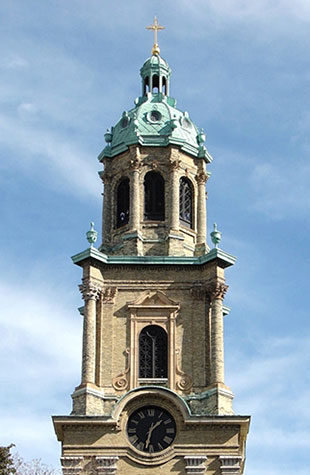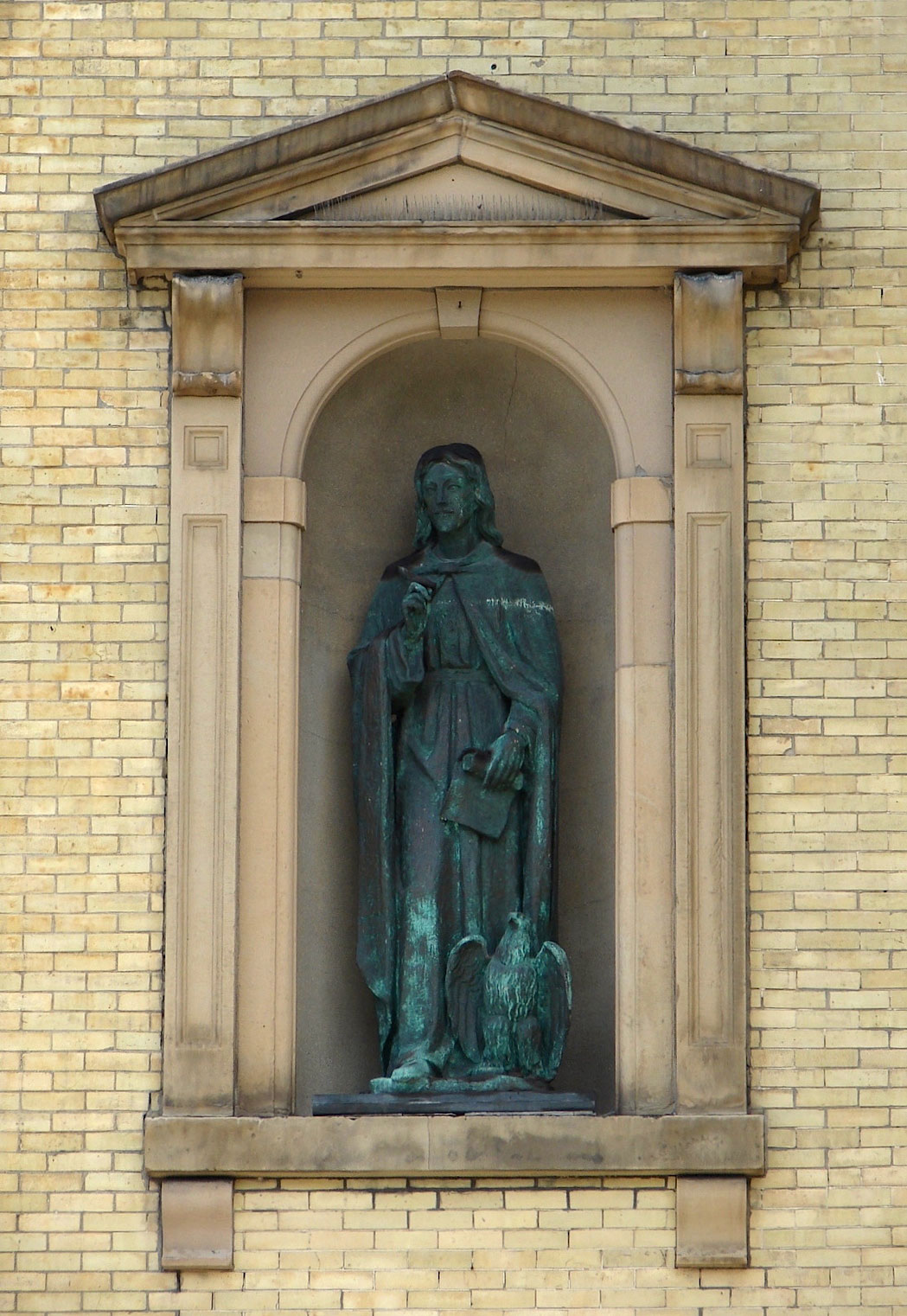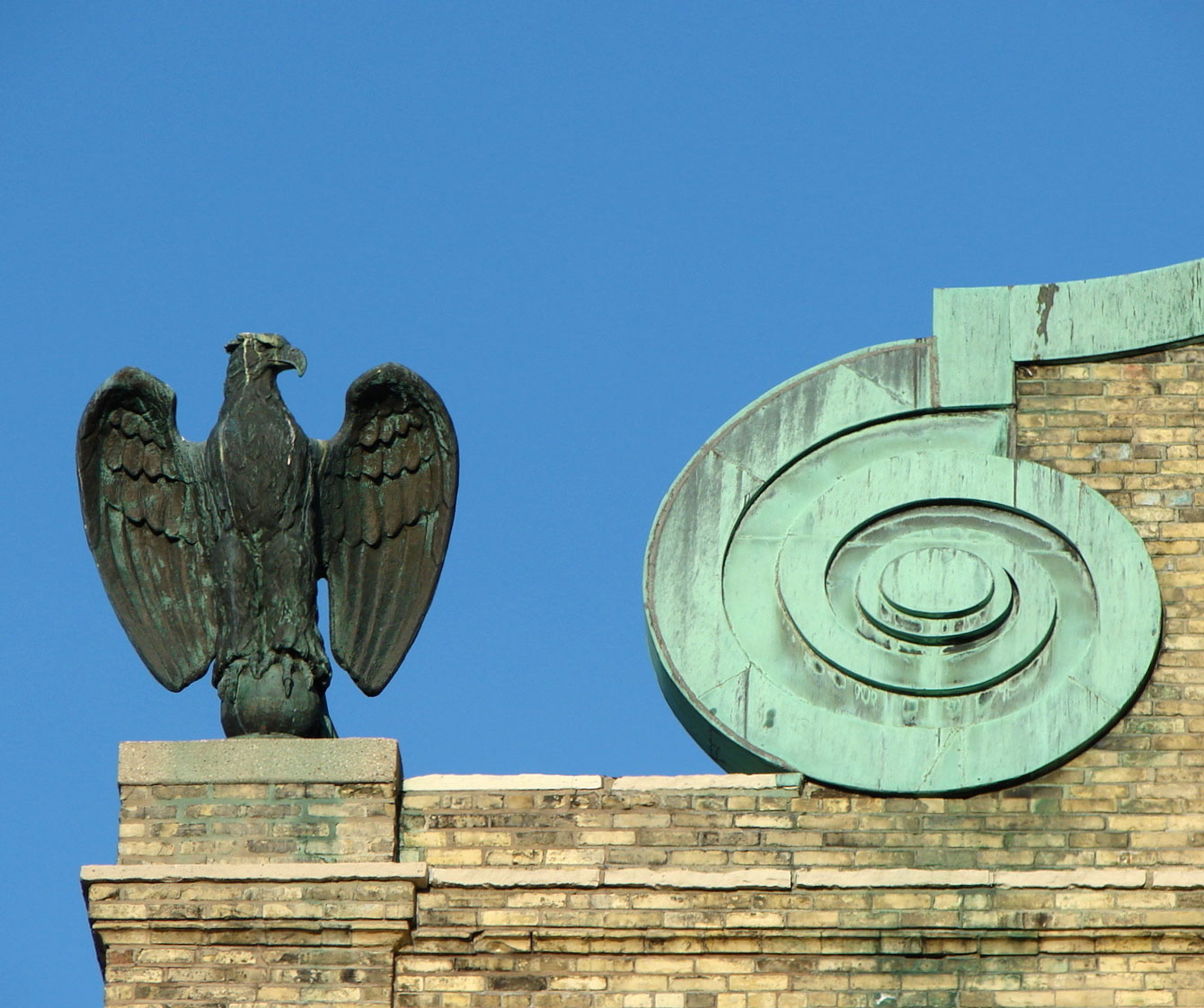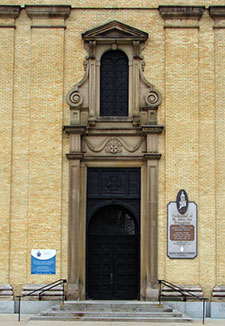2. Catholic Cathedral of St. John the Evangelist, 1847
802 North Jackson Street (at East Wells Street)
Architect: Victor Schulte
Milwaukee was a booming frontier city in the late 1840s, with Catholics making up a substantial number of the new arrivals. The first Catholic church in the city, St. Peter’s, was a wooden building of modest size. Even with the anticipated departure of the German-speaking Catholics to St. Mary’s, St. Peter’s was too small for the growing population of English-speaking Catholics, most of whom were Irish immigrants. The builder-architect Victor Schulte was therefore retained in 1847 to design a new and much larger church, on a site two blocks south of St. Peter’s and just three blocks east of St. Mary’s, which was then still under construction. (St. Peter’s Church was later moved to St. Francis Seminary, south of Milwaukee, and moved a second time to its present location at Old World Wisconsin, an open-air museum operated by the Wisconsin Historical Society.)
Like St. Mary’s, the Cathedral of St. John the Evangelist exhibits the characteristics of the German Zopfstil, at least from the ground up to the eaves. Pilasters with plain capitals and windows topped by simple triangular pediments give the building a sense of dignity and restraint. At the same time, since St. John’s was to be the cathedral for the diocese rather than simply a parish church, bishop Martin Henni undoubtedly wanted the new building to be not only larger than St. Mary’s, but also more ornate. Consequently, Schulte topped off the cathedral with an elaborate Baroque bell tower. Only the first two stages of the tower, up to and including the clock faces, date to the original construction of the cathedral. Above this, the original tower had a smaller third stage ringed by a balcony and topped by a bell-shaped roof. The scrollwork parapet flanking the second stage of the tower and the ornate front entrance at the tower’s base are additional Baroque features that go beyond the typical restraint of the Zopfstil. The new cathedral was an ambitious undertaking for its time in Milwaukee and the diocese struggled to raise sufficient funds to keep the project going. As a result, the building took six years to complete, with dedication of the finished cathedral in the summer of 1853.
The original upper portion of the tower, constructed of wood, deteriorated in the decades following its construction. City inspectors determined the tower to be structurally unsound and ordered its removal in 1880. The tower then had a rather truncated appearance for more than a decade, until the Archdiocese of Milwaukee (elevated from a diocese in 1875) commissioned the architectural firm of Ferry and Clas to design a replacement. The new tower, completed in 1893, is the design seen on the church today. The yellow Cream City brick of the main block of the church and the lower stages of the tower had weathered and darkened by the 1890s. In order to match this color in the new stages of the tower, brick of approximately the same age was salvaged from a house then undergoing demolition. The new tower is taller than the original, with a square stage above the clock faces and an octagonal stage above that, topped by a dome, small lantern, and cross. The octagonal stage with its dome and lantern bears a strong resemblance to the tower of the Church of the Holy Trinity in Paris, built in the 1860s, which the architects probably knew from a book or architectural journal of the period.
St. John’s Cathedral suffered a disastrous fire in January of 1935, causing much of the roof to collapse and destroying the east end of the building as well as the organ and stained glass windows. The tower and west wall remained with relatively minor damage, along with most of the north and south walls. Reconstruction began in 1937, based on plans by architect Richard Perry of Pittsburgh. The cathedral as originally built had no interior columns, with a coved ceiling spanning the entire width of the building. Perry’s reconstruction included two rows of columns, dividing the worship space into a wide nave and two narrow side aisles. Each of the columns is more than 33 feet in height including the bases. The ornate Corinthian columns enclose structural steel columns that help to support the steel roof trusses, a more fire-resistant replacement for the original wooden roof structure. The cathedral was also enlarged at this time, with the east end extended 65 feet so that the building now covers the entire length of the block from Jackson to Van Buren Streets. As with the reconstruction of the tower in the 1890s, work on the exterior walls incorporated older brick of matching color from demolished buildings. The reconstruction work took several years, with the first Mass in the reopened cathedral celebrated on Christmas Eve of 1942 and the last of the present stained glass windows installed in 1943.
In the 1970s, the bronze statues of St. John the Evangelist and St. Peter were placed in the niches above the side entrances on the façade. The statues are a bit larger than life size at 7½ feet tall. The two bronze eagles on the façade parapet (symbolic of St. John the Evangelist) also date to the 1970s. These replaced the original eagles, made of wood and covered in copper, which were damaged in the 1935 fire. The bronze eagles are each 5½ feet high and weigh 950 pounds.
Along with interior renovations completed in 2002, the exterior walls of the cathedral were cleaned, removing a century and a half of accumulated dirt and soot. Milwaukee was for much of its history a much smokier city than today, as is evident when comparing the exterior of St. John’s to that of St. Mary’s. Both churches date to the 1840s and are built of the same Cream City brick, but St. Mary’s has never been cleaned and today is mostly black, while the recent cleaning of St. John’s has revealed the original yellow color of the brick.
Sources:
Bolton, Harry. The Centennial History of St. John’s Cathedral, 1847-1947. Cathedral of St. John the Evangelist, 1947.
Heinen, Tom, and Beth Kormanik. “A ‘Glorious’ Renovation,” Milwaukee Journal-Sentinel, February 3, 2002, page 2B, column 2+.
Perry, Richard, architect. Prints of drawings for reconstruction of St. John’s Cathedral, dated March and April 1937. Wisconsin Architectural Archive, Milwaukee Central Library, drawing set 144-1.
Seventy Five Years at Saint John’s Cathedral. Cathedral of St. John the Evangelist, 1922.
“St. Peter, St. Matthias, St. Jude Windows are Installed in Cathedral,” Catholic Herald Citizen, April 24, 1943, page 4, column 4.
Verhaalen, Marion. A Journey in Faith: 150 Years at the Cathedral of St. John the Evangelist, 1847-1997. Cathedral of St. John the Evangelist, 1997.
White, Dorothy. “5,408 Pieces of Glass Form First Window Installed in Cathedral,” Catholic Herald Citizen, October 24, 1942, page 7, column 2.




